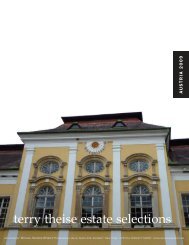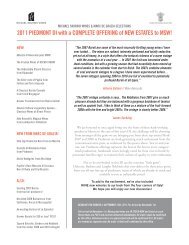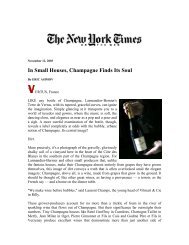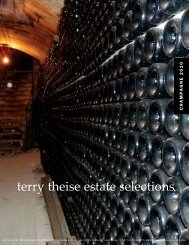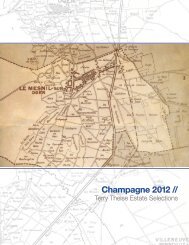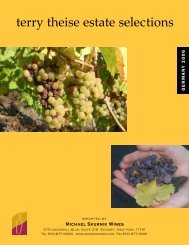View 2013 Champagne Catalog - Michael Skurnik Wines
View 2013 Champagne Catalog - Michael Skurnik Wines
View 2013 Champagne Catalog - Michael Skurnik Wines
Create successful ePaper yourself
Turn your PDF publications into a flip-book with our unique Google optimized e-Paper software.
Moussé Fils<br />
Vallée de la Marne // Cuisles<br />
vineyard area // 5.5 hectares<br />
annual production // 4,100 cases<br />
villages & soil types // Cuisles, Jonquery, Olizy-Violaine, Châtillon-sur-marne<br />
(chalk, marl)<br />
grape varieties // 80% Pinot Meunier, 16% Pinot Noir, 4% Chardonnay<br />
It was my first appointment the morning after the big snowstorm that paralyzed northern<br />
Europe in mid-March. Cuisles is, let’s say, not on the main road, and I was curious how<br />
I’d manage. But <strong>Champagne</strong> sure was pretty in the snow, and I managed to glissade my<br />
way there.<br />
Vallée de la Marne<br />
Moussé Fils<br />
Several years ago Didier Gimonnet told me there<br />
would be a new member of the Club Tresors (of which<br />
he was then president) who would provide the very first<br />
Spécial Club bottling entirely from Meunier. He added<br />
that the guy was still below-the-radar but definitely an up<br />
and comer, a super-nice man, young and ambitious.<br />
So I made a beeline. And all of it was true. I had long<br />
been aware of the Meunier-Rennaissance taking place<br />
way up-valley in the Marne, in all the terra incognita<br />
near Château Thierry, an ad-hoc group of growers who’d<br />
rediscovered their old vineyards and wanted to give<br />
Meunier the respect it almost never got. I went first to<br />
Loriot in Festigny, liked the people and the wines (and<br />
especially liked the landscape, the loveliest I think in all<br />
of <strong>Champagne</strong>), and mixed a case to ship back and drink.<br />
I then went to Cuisles, to find young Cédric Moussé.<br />
Getting to Cuisles is no simple matter. You make one turn<br />
off the Marne into a side-valley, and then another turn off<br />
the side valley into an even smaller valley, and then another<br />
turn to the quietest most out of the way village, one of<br />
those places where you can hear the chickens clucking in<br />
the next village, it’s so still.<br />
I visited twice and assembled wines both times. I<br />
emphasize this point, because I find it urgently necessary<br />
to drink the wines as you do, before I commit to a new<br />
agency. Tasting of course is fine, but wines are one way<br />
being “tasted” and another way being “drunk.” And I<br />
need to see, as I work my way through a case, if the wines<br />
remain as interesting and attractive as they seemed at the<br />
moment of “tasting.” A wine that shows well but grows at<br />
all tiresome after the 4th or 5th exposure is too superficial.<br />
What I liked and admired about Moussé’s wines was<br />
their poise and polish. They were refined, even intelligent<br />
for Meunier wines. As a rule the Meunier <strong>Champagne</strong>s go<br />
either into deeply earthy areas (e.g., Chartogne’s Les Barres)<br />
or they’re hedonistic fruit-bombs, but Moussé seems both<br />
to thread the needle between those profiles and to add<br />
something of his own. I would call that thing “good posture,”<br />
but that’s a silly Terry-image and you may not know what<br />
I mean by it. Put it this way; the <strong>Champagne</strong>s are highly<br />
flavory and loaded with Meunier charm, but they’re also puttogether,<br />
color-coordinated, all the flavors “drape” perfectly;<br />
they’re fit, symmetrical, contained. They don’t sprawl.<br />
Cuisles has 20-40cm of topsoil over what Cédric calls<br />
“schiste.” The existence of such a soil in <strong>Champagne</strong> was<br />
news to all of us. He swears there is a vein of schist running<br />
from Villers-Sous-Châtillon directly through Cuisles, and<br />
to his knowledge it’s unique in <strong>Champagne</strong>. If you go to<br />
his (or our) website you can look at photos. The sub-soils<br />
are porous but the roots can’t penetrate them. Other soils<br />
are the usual mixture of marls and micraster chalk common<br />
to this part of <strong>Champagne</strong> – but we have to understand<br />
the geology behind Cédric’s claim, and also resist the<br />
temptation to assume we’re “tasting” it—though we’re<br />
certainly tasting something and it might as well be schist.<br />
The estate is 5.5 hectares. “I don’t want it to be too<br />
big; then I couldn’t go to the vineyards,” he says. The<br />
new winery is indeed impressive, especially from the<br />
Moussé at a glance // Our favorite among the Meunier pilgrims in the Marne Valley (and elsewhere), an up-andcoming<br />
young grower who’s the newest member of the Club Tresors.<br />
how the wines taste // Classy Meunier beauties; savory and dark-bready and with the sorghum-sweetness of<br />
the variety, but also with a certain reserve and containment – elegance is the right word.<br />
26



